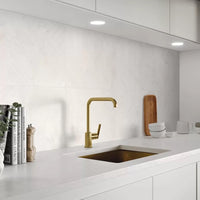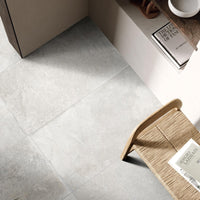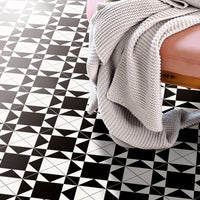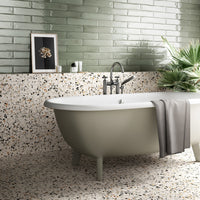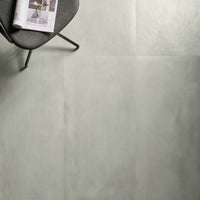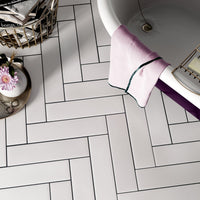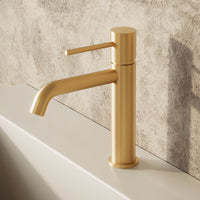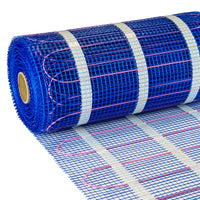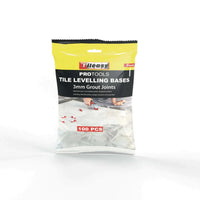Tiling your own home is extremely rewarding. Not only will it transform your space, as an added bonus it will save you a few pennies, too! But it can be daunting, even if you’re experienced with DIY projects. In this article, we’ll discuss the best ways to cut wall and floor tiles, helping you ensure a beautiful finish on your next kitchen or bathroom project.

Why do tiles need cutting?
Wherever your project, it’s almost a given that you’ll need to cut some tiles. There’s always obstacles in the way, such as a toilet on a bathroom floor or electrical sockets on a kitchen wall. And your new tiles will likely need to be cut when they reach the edges of a room.
Usually, the only time tiles don’t need to be cut is when you’re tiling a very small splashback, above a cloakroom washbasin, for example.
How to cut tiles
Whether you’re cutting hard porcelain tiles or softer ceramic tiles, you’ll always need the following equipment:
- A suitable tile cutter
- A tape measure
- Goggles and gloves
- A tile marker
- A tile file
Different types of tile cutters exist and below, we'll run through which cutter is right for you and your project.
We recommend investing in a high quality tile cutter, as these will help you achieve a better finish. Borrowing or renting tools is a great idea, especially if you're not likely to tile another room anytime soon. Always make sure that the blade or cutting wheel is as fresh as can be.
When it comes to cutting your tiles, the basic principle is the same, whichever cutter you choose:
- Use the tape measure to measure the cut
- Use the marker to mark the cut onto the tile
- Use the cutter to cut the tile
- Use the tile file to smooth any sharp edges
Before we move on, there's two important pieces of advice to remember:
- Always wear safety equipment, as tile shards and exposed edges can be very sharp
- Measure twice and cut once, to ensure that your cuts are right first time and tiles aren't wasted
How to choose the correct tile cutter
There are four main types of tile cutter - manual and electric cutters, tile scribes and tile nippers.
You should choose a suitable cutter based on the type of tile you’re working with and the cut you wish to achieve. In our experience, it's always best to have a manual and an electric tile cutter in your tool cupboard - especially if you're planning on tiling multiple rooms.
1. Tile scribes
Tile scribes are inexpensive and easy to use. They have a tungsten carbide tip that is used to score the tile glaze, before snapping the tile.
- Can only be used for straight cuts
- Can only be used on thin ceramic wall tiles
- Great for splashbacks
2. Manual tile cutters
Manual tile cutters work by scoring the tiles with a diamond tipped wheel, before snapping them using a breaker.
- Available in a wide range of sizes and prices
- Can be used to cut straight and diagonal lines
- Easy to set up and very quick to cut tiles
- Very little mess generated
- Can be used on both ceramic and porcelain tiles, depending on the breaking power
- Great for smaller projects with a lot of similar cuts
3. Electric tile cutters
Electric tile cutters feature a rotating diamond tipped wheel, that's kept cool by fresh water. They're available as as table-top cutters, for smaller tiles, and freestanding cutters, for larger tiles.
- Can be used for straight, L shape, U shape and curved cuts
- Can be used on ceramic, porcelain and natural stone tiles
- Can be used to cut grooves or mitred edges into tiles
- Requires more time to set up
- Generates waste water and ceramic material
- Great for larger projects where a variety of cuts are required
4. Tile nippers
As with the scribing tools, tile nippers are handheld and easy to use. They're great for cutting curves and notches, where you can't use a manual tile cutter. However they do require a lot of patience.
- Can only be used for curves, notches and cut outs
- Ideal for ceramic, mosaics and thin porcelain tiles
- Great for areas where accurate detailing is required
How to use a tile scribe
Although tile scribes may seem basic, they’re ideal for cutting straight lines in small, thin ceramic tiles, such as metro tiles. They can also be used to score lines and curves in other tiles, before using other cutters.
- Measure and mark the tile you wish to cut
- Score the marked line using the sharp end of the scribe. You can run it against a flat edge, for a neater cut
- Place the scribe underneath the tile, so that the scored line sits directly above the scribe
- Push your hands down on the two sides of the tile, so that it snaps along the scored line
How to use a manual tile cutter
Using a manual tile cutter is simple and relatively quick, even if you're a beginner. They usually consist of a cutting wheel that moves along a fixed bar, to ensure a straight and consistent cut. The wheel is moved by pushing a handle or bar forwards.
- Set the cutter up on a workbench or stable table
- Measure and mark the tile you wish to cut
- If your cutter comes with a guide, you can set this at the required measurement
- Position the tile on the bed of the cutter, with the glazed surface pointing up
- Ensure the cutting wheel and mark are in line, by running the wheel just above the tile
- When you're ready to cut, press the cutting wheel firmly into the bottom edge of the tile
- Firmly push the handle forward, to move the wheel along the marked line and score the glaze
- Once you reach the other end of the tile, use the built-in breaker to snap the tile. This differs from cutter to cutter, but usually involves lowering the handle to apply pressure to the end of the tile
- The tile should snap along the scored line
- If required, smooth the cut edge using a tile file or filing stone.
Sometimes, a little technique is required so it's a good idea to test first on a broken or damaged tile. For example, some stronger tiles may need to be scored twice while glossy ceramic tiles usually only require a light score.
How to use an electric tile cutter
Electric tile cutters are slightly more involved than manual cutters and require a little more patience.
You'll need an electrical socket close by and a source of water, to fill up the reservoir. If cutting inside, it's a good idea to use plastic sheets to protect the rest of your room from excess water and debris. Once you've finished cutting, give the cutter a thorough clean to remove any sludge and waste material.
- Set your cutter up. If using a tabletop cutter, set this up on a stable workbench
- Measure and mark the tile you wish to cut
- If your cutter comes with a guide, you can set this at the required measurement
- Position the tile on the bed of the cutter, with the glazed surface pointing up
- Turn the cutter on. You are ready to cut once the wheel is being sprayed with water and is running at full speed
- If using a table top cutter, you will need to feed the tile into the spinning wheel, which is fixed in place
- If using a freestanding cutter, you will need to plunge the spinning wheel into and along the tile, which is fixed in place
- Whichever cutter you use, let the blade do the work so that the motor isn't placed under too much stress. A slower cut is usually a smoother cut.
- Keep the water level topped up and switch the blade off after each tile is cut
- An electric tile cutter usually offers a very good finish, but you can smooth the cut edge using a tile file, if required
Naturally, electric tile cutters can be daunting to use. You should always test the machine and your cutting technique first, on broken tiles. Always wear safety goggles and only start cutting tiles when you feel confident and ready.
How to use tile nippers
Although they're not required on every project, tile nippers are an important tool, especially if awkward shapes or intricate detailing are involved. They can be used to cut small sections of tile, bit-by-bit and aren't designed for simple, straight cuts.
They should usually be used in conjunction with a tile scribe to score the glaze, although many nippers also feature scoring wheels.
- Measure and mark the tile you wish to cut
- Score this marked line using a tile scribe
- Hold the tile in-between the teeth of the nippers and press the handles together, to nip a small part of the tile away
- You will need to start at one end of the marked line and nibble along the line, piece by piece, until the desired cut is achieved
- If required, smooth the cut edge using a tile file or filing stone
Can I use an angle grinder to cut tiles?
By and large, we don't recommend using an angle grinder to cut tiles, for two reasons. They're likely to create a lot of dust and, as the blade tends to spin extremely fast, can easily cause tiles to crack or chip. Furthermore, the cut itself is rarely as neat as a cut achieved with a dedicated tile cutter.
If you must use an angle grinder, then we recommend it's only used for intricate cuts, that a manual tile cutter is unable to achieve.
Always use a blade that's designed for cutting ceramic or porcelain tiles and where possible, secure the tile in place using a clamp. Wearing safety goggles and a mask is a must, due to dust and debris.
How to cut curves into tiles
Sometimes, you may need to cut curves into your tiles. For example, if you’re re-tiling an existing bathroom you might need to fit tiles around a toilet or quadrant shower enclosure. This isn’t as tricky as it sounds, especially if you use a profile gauge tool, which is designed to replicate the shape of the obstacle.
- Press the profile gauge against the obstacle, until the needles form the required outline
- Hold the profile gauge over the tile and copy the outline onto the surface of the tile
- Score the outline using a tile scoring tool
- Use an electric tile cutter to cut 10mm wide slithers through the waste part of the tile, up to the scored outline.
- Eventually, the tile will resemble a comb with slithers of narrow tile
- Use tile nippers to cut each slither away. As the tile has been scored, these should break easily
- You can slowly run the cut curved edge against the electric tile cutter blade, to gently smooth out any bumps
This method can also be used for other intricate cuts, for example around doorway architraves.
How to cut L and U shapes into tiles
At some point, you may need to cut L or U shapes into your tiles, to fit around electrical socket or shower drain covers, for example.
To cut an L shape
- Measure and mark the required lines onto the tile
- Score the two lines using a manual tile cutter
- Use an electric tile cutter to cut the first line, stopping just short of the corner where the two lines meet
- Cut into the corner very slowly - you may need to lift the tile up slightly, to let the blade work through the body of the tile
- Repeat for the second line
- Once the cut is complete, you may need to clean any excess material from the internal corner using tile nippers
To cut a U shape
- Measure and mark the required lines onto the tile
- Score the middle line using a manual tile cutter
- Use an electric tile cutter to cut the two end lines, ensuring the cuts meet the ends of the scored line exactly.
- This waste part of the tile can be knocked out, by gently tapping with a rubber mallet. It should snap cleanly along the scored line
Using a tile file
Sometimes, the cut edges of your tiles may be very sharp. Depending on your project, you may wish to smooth these down, especially if they’re visible or exposed.
You can use a tile file to dull this finish, by running the file back and forth along the cut edge. While tile files are made from aluminium oxide which is extremely tough, they do require some time and effort, so they’re best suited to smaller jobs and ceramic tiles.
